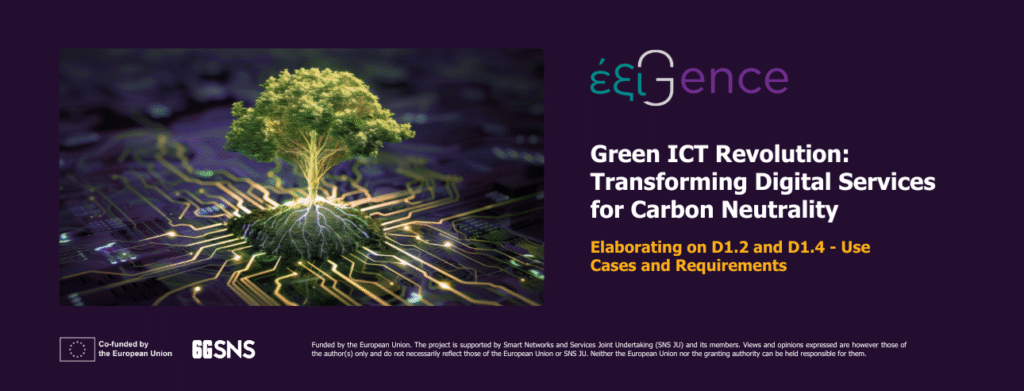
Introduction: Building a Sustainable Digital Future
The digital revolution has transformed how we live, work, and communicate, but it comes with an environmental price. As Information and Communication Technology (ICT) services consume ever-increasing amounts of energy across networks, data centres, and devices, the urgent need for carbon neutrality in the digital sector has never been more relevant. The EXIGENCE project addresses this challenge through multi-domain research that brings transparency to the carbon footprint of digital services.
EXIGENCE “Use Cases and Requirements” deliverable represents a mature, consolidated framework for enhancing energy consumption and carbon emission visibility throughout the complete end-to-end digital service chain. This document, initially reported as D1.2 with a refined and revised version released as D1.4, aims to explore a comprehensive range of use cases along with their associated requirements, focusing on enhancing exposure regarding energy consumption and carbon emissions in digital services.
Main Content: Revolutionising Digital Service Sustainability
The journey from D1.2 to D1.4 demonstrates the project’s commitment to continuous improvement and stakeholder engagement. While D1.2, published in May 2025, introduced the initial suite of use cases including media streaming carbon footprint transparency, digital sobriety, and green scheduling, D1.4, published in October 2025, represents a significant advancement through:
- Expanded Use Case Coverage: The document now includes 16 use cases (expanded from 15 in D1.2), with the addition of “Enabling Greener Service Consumption,” which focuses on subscriber energy credit limits and Mobile Network Operator suggestions for energy reduction during peak-load conditions.
- Requirements Consolidation: D1.4 provides enhanced consolidation of use case requirements, organised into clear categories with improved focus on minimising communication overhead and environmental impact. Requirements have been generalised to apply across multiple domains, creating a more comprehensive framework.
- Standards Integration: Several use cases from D1.4 have been submitted to 3GPP SA1 Release 20 study item on “Energy Efficiency as service criteria,” including media streaming carbon footprint transparency, carbon certificates as a service, and energy-efficient content download mechanisms.
Core Use Case Groups: Comprehensive Solutions for Green ICT
1. Media Streaming Group: Empowering User Awareness
The media streaming group addresses the visible aspect of digital carbon footprint for users. As an example, the use case, “Media Streaming Carbon Footprint Transparency,” proposes displaying real-time metrics such as “Instant Carbon Footprint” or “Total Daily CO₂” during video streaming, similar to how users currently view battery status or connectivity strength.
This transparency enables informed decision-making through “Digital Sobriety” mechanisms that suggest environmentally friendly alternatives, such as accepting lower video resolution or scheduling downloads during green energy periods. The system includes both economic incentives (environmental points convertible to monetary rewards or lottery participation) and behavioural incentives (badges, social recognition, and peer comparison).
2. Green Batch Scheduling: Optimising Behind-the-Scenes Operations
This group focuses on carbon-aware scheduling for energy-intensive operations that can be delayed. The “Carbon-Aware AI or Batch Service Provisioning” use case introduces green windows for AI model training or inference, and content distribution network (CDN) pre-population based on energy mix forecasts.
The “Green Social Media and E-mail Content Download” use case addresses the 7.9 billion users accessing instant messaging and email services worldwide by postponing attachment downloads to moments when energy mix conditions are favourable or radio signal conditions are optimal.
3. Green Real-Time Scheduling: Dynamic Network Optimisation
Real-time scheduling use cases focus on immediate optimisation opportunities. “Energy Profiling on Network Devices” creates energy profiles for network nodes, mapping efficiency index that indicate confidence levels for executing tasks in an energy-efficient manner.
“Green Network Orchestration in the Edge” addresses resource contention issues by implementing carbon-aware admission control and resource allocation, ensuring that service quality thresholds are maintained while minimising environmental impact.
4. Energy Efficiency Services: Market-Based Solutions
This group introduces market mechanisms for carbon management. “Carbon Certificates as a Service” enables service providers to obtain and trade carbon certificates, creating economic incentives for sustainable practices. “Carbon Emission Charging” implements pricing mechanisms from end-to-end energy measurements that reflect the environmental cost of digital services.
Cross-Domain Requirements: Enabling Interoperability
D1.4 establishes comprehensive technical requirements across three main categories:
- Inter-Domain Requirements: Enable different service providers to exchange energy consumption and carbon emission data with minimal communication overhead. These requirements ensure that ecodata is meaningful and accessible across the enabled domains.
- Intra-Domain Requirements: Implement energy profiling and efficient resource management within individual domains, including time-continuous measurements of software processes and hardware components.
- Application Requirements: Develop user interfaces that present environmental information and incentives, ensuring that sustainability features are seamlessly integrated into existing user experiences.
Industry Impact and Standardisation
The project’s contribution to 3GPP standards represents a step toward industry-wide adoption. Multiple D1.4 use cases have been accepted into technical report 3GPP TR 22.883, including:
- Media streaming carbon footprint transparency to end user terminals
- EC and CO₂e transparency to any service provider in the end-to-end service chain
- Energy efficient, carbon aware, content download
- Carbon Certificates as a Service
This standardisation ensures interoperability across different network operators and service providers, creating a foundation for scalable implementation of green ICT principles across the telecommunications industry.
Real-World Applications and Business Impact
The use cases address practical scenarios that resonate with everyday digital experiences. For example, the “Watch TV over 5G/6G” use case addresses users who want to stream content on large screens using mobile hotspot connectivity while maintaining environmental awareness.
Industrial applications include “Physical Security in Industry,” which enables continuous energy profiling of private 5G/6G camera streams and AI analytics in cloud environments, allowing businesses to optimise security infrastructure for both performance and environmental impact.
Conclusion: Charting the Path to Carbon-Neutral ICT
EXIGENCE D1.4 represents a comprehensive roadmap for achieving carbon neutrality in the ICT sector through systematic measurement, optimization, and incentivisation. The document is an evolution from previous D1.2 demonstrating the project’s commitment to stakeholder engagement, technical rigor, and practical applicability.
The key achievements include the successful expansion from 15 to 16 detailed use cases, the consolidation of over 100 requirements into a coherent framework, and the acceptance of multiple use cases into international standards. These accomplishments position EXIGENCE as a reference toward sustainable digital services.
The project’s approach, spanning user awareness, infrastructure optimisation, market mechanisms, and standardisation, creates multiple pathways for reducing the environmental impact of digital services. As 5G and 6G technologies continue to evolve, the principles and technologies developed through EXIGENCE will be essential for ensuring that technological advancement aligns with environmental responsibility.
The successful integration of user engagement through transparency and incentives, combined with behind-the-scenes optimisation through intelligent scheduling and resource management, demonstrates that environmental sustainability and user experience are not mutually exclusive. Instead, D1.4 shows how they can be combined to create a more sustainable and efficient digital ecosystem.
Read EXIGENCE D2.1 – Metrics for Energy Consumption and Efficiency Metering: HERE
Author

Telefónica Innovacíon Digital
Luis M. Contreras, Ph.D, is with Telefónica Innovación Digital / CTIO, working on scalable transport networks. He participates in several EU Research and Innovation projects (lately Horizon Europe CODECO, and SNS DESIRE6G, 6GREEN, EXIGENCE, and UNITY-6G). He is an active contributor to different SDOs, such as IETF, O-RAN, ETSI, etc.
